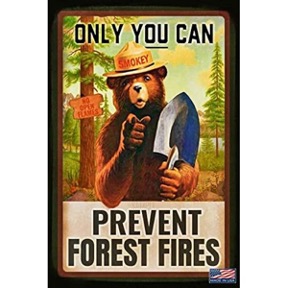
Historically, fire was used as a tool by Native Americans to reduce understories and to purposely alter the landscape. In the early 1900’s, fire became a hot topic in the U.S. due to wildfires. Gifford Pinchot, considered the father of forestry as the first chief of the U.S. Forest Service, wanted to control and prevent fire. At the time, there were many disagreements surrounding the intentional setting of fires, a practice called prescribed burning. It wouldn’t be until years after Pinchot’s time that fire would be recognized as a tool again.
In 1910, a fire that would change fire history occurred. A large wildfire, called the Big Blowup, burned 5 million acres across Idaho, Montana, and Washington and took the lives of 86 people. The conflagration was the result of multiple small fires joining into one huge fire. As a result of this fire, in the 1920’s the saying “Put it Out” became popular. By the 1930’s, the Civilian Conservation Corps had fire crews that soon adopted a new fire practice called the ’10 a.m. Policy’. This policy meant that all fires should be put out by 10 a.m. the next day. Fire at this point in history was not thought of as a tool but rather a nuisance that needed to be controlled and prevented.
In 1944, the first fire prevention poster was published. The poster was of the famous Disney character Bambi and was directed at the prevention of forest fires. In that same year, the character Smokey Bear was created by the Forest Service and was used to publicize the importance of fire prevention. The phrase of the 1940’s “Only YOU can prevent Forest Fires” became a well-known U.S. slogan.
It wasn’t until the 1970’s that fire was beginning to be recognized as a tool again. Some fires were left to burn to restore natural fire conditions. By 2001, the famous Smokey line was changed to “Only YOU can prevent Wildfires”. At this same time in history, fire behavior began to change. Fires became more intense and larger. The term “Mega Fires” became popular and to this day the theory is put forward that we are currently in the Era of Mega Fires. The fire policy that the Forest Service follows today is called the Cohesive Strategy, which has as its primary goals to restore and maintain the landscape, to fire-adapt communities, and to respond to wildfires in a safe and effective manner. The new strategy includes the expansion of prescribed fire as a means of reducing the threat of high-intensity fires and of improving the health of the forest. Fire today is used as a tool to manage forests and restore a more natural fire pattern to the landscape. If wildfires do occur, they are managed and put out if life or property are at risk.
Fire history. National Centers for Environmental Information (NCEI). (2024, March 20). https://www.ncei.noaa.gov/products/paleoclimatology/fire-history
National Cohesive Wildland Fire Management Strategy. National cohesive wildland fire management strategy. (n.d.). https://www.forestsandrangelands.gov/strategy/
